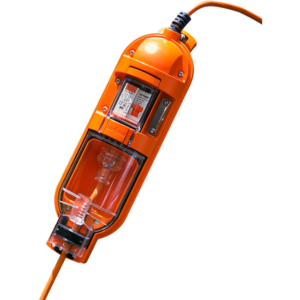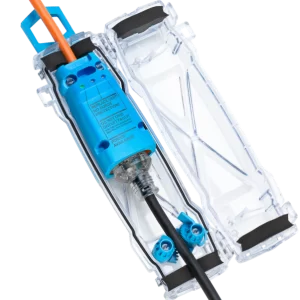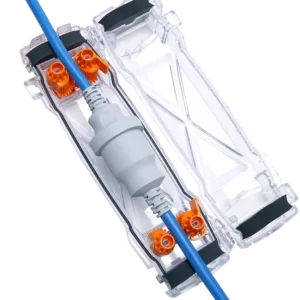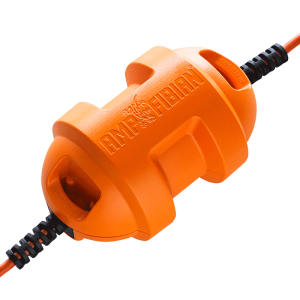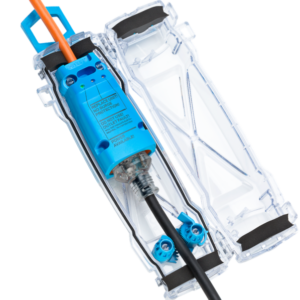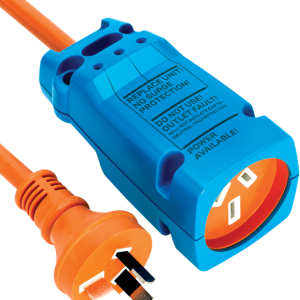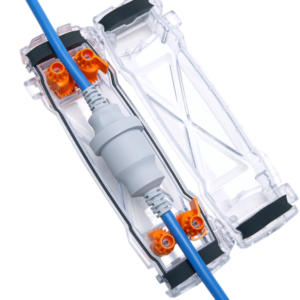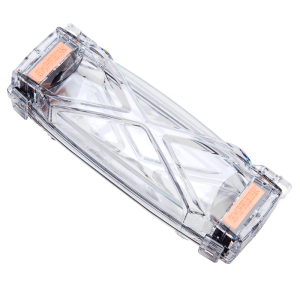Surge Protectors
It is the first portable surge protector for caravans and RVs, and it has a “traffic light” outlet tester that allows you to test the circuit you’re about to plug into.
The surge protector is the complete solution to all caravanner’s needs “no more dicking around”:
- Connects directly (and legally) to the caravan’s power supply cable (15A plug and socket);
- It does not require a certified electrician to install or replace;
- It comes in a weatherproof housing (IP55);
- Protects everything in your caravan (inverter, appliances, etc.)
The integrated outlet tester has a simple “traffic lights” indicator:
- GREEN means there is power available and you’re good to go;
- ORANGE means the surge protector has died protecting your expensive gear and needs replacing;
- RED means “Stop”, incorrectly wired outlet, do not use (unless it’s a portable generator).
The surge protector is compatible with Ampfibian 15A to 10A caravan power adaptors (RV-PLUS and MAX) for use at home or at a mate’s place
A power surge or power spike is a very short (fractions of a second), very high rise in voltage. The increase is too fast to trigger fuses or RCDs (residual current devices).
Surges are caused by lightning striking the electricity grid, electric motors starting up or shutting down, heavy equipment being switched and by (portable) generators during start up and shut down, especially when they run out of fuel.
Where you are on the electric grid also has an impact – a dense city grid has more controls; long distant country transmission lines (like single-earth return lines) are far more vulnerable to surges, brownouts, over-voltages and switching issues.
Surges damage electronic equipment by causing internal arcs, which burn through insulation causing short circuits i.e. permanent damage.
Surge protectors either absorb or re-direct the power surge to earth before it reaches the protected equipment. If the surge is higher than the surge protector’s rating, it will sacrifice itself protecting the circuit. They contain near-instantly acting solid state components.
The Joule is a unit of energy. It shows how much power a surge protector can absorb before being permanently damaged. A higher rating means a longer service life. The S1000D’s 1000 Joule rating gives you the assurance of sufficient protection for your valuable caravan or motorhome.
Repeated exposure to surges will eventually “wear out” the protecting components as they can only absorb so much energy over their life. Internal fuses will disconnect the surge protection components when they can no long provide adequate protection. This is indicated when the orange light on the tester comes on, warning you to replace the protecting unit.
There are no surge protected 15A power boards and definitely no weatherproof ones. Use of un-approved (e.g. incorrectly used, installed or illegally modified equipment) is not just dangerous, it also lets insurance companies wiggle out of payment in case of a claim.
No, most warranties and insurance policies specifically exclude surge damage. Check your policy and your equipment warranties… and keep in mind the cost of your excess in case of a claim.
This will protect the appliance plugged into it but leaves your inverter and all hardwired equipment (e.g. power management system and battery chargers) unprotected. The Ampfibian 15A surge protectors protect your whole van
No, but not much will. A surge protector will protect against a power spike from a lightning strike on the grid, but not a direct hit.
Lightning arrestors protect against direct lightning strikes. These are found in buildings and infrastructure installations because they are big, heavy and require dedicated earth connections.
It checks the supply power point has been wired correctly and indicates if it is safe to use or not. If the red light comes on, don’t plug anything else into that outlet (and do the right thing and let somebody know so it can be fixed).
No, surge protectors take 1-3 nanoseconds to act, while fuses are much too slow. Power surges do not last long enough to heat and trip conventional fuses or circuit breakers.
That’s called reverse polarity: electric motors, computers, DVD players, etc., all rely on correct polarity to function properly. It might also cause under-voltages which damage electronic equipment. This is the most common wiring fault
“Earthing” or “grounding” is the best way to protect people in case of an electrical fault. It provides an alternative path to ground, much better than through YOU! A “missing earth” is extremely dangerous, removing the most basic electrical protection.
No, Residual Current Devices (RCDs) protect against electrical faults that may cause electrocution. Fuses, RCDs and surge protectors all detect and protect against different faults.
Adaptors
“A” is the abbreviation for Amperes (“amps”) which is the unit for measuring electric current. If you multiply Amperes (A) and Volts (V) you get total power which is expressed in Watts (W).
As most domestic appliances use a constant 240V you need to supply more current (A) to keep to get more power. The more current goes through a wire, the hotter it becomes. Fuses and breakers are put into circuits to protect the wiring from having too much current flowing through them. If this protection is not in place, then the wires can get hot enough to cause a fire.
A Residual Current Device is an extremely fast acting switch that cuts the power when it detects a difference in the power going into the circuit against the power coming back out. If a difference is detected then the RCD trips almost instantly as the power must have found a way to go somewhere else other then back to the supply. This path may be through a faulty appliance, faulty wiring, or at worst – through you! These devices have saved countless lives by cutting the electricity supply before it can cause severe damage. An RCD does not sense overload (i.e. total amount of power drawn) which is why Ampfibian caravan adaptors do both.
Please note that RCDs do not offer protection when used with isolated supplies like small generators or inverters.
Modern caravans and RVs draw more power and are more dependent on electricity than ever before. You only need to have your air conditioner running and pop something in the microwave to overload your powerpoint. That’s why RVs and caravans are connected to 15A circuits and why you need a 15A to 10A adaptor.
If you are connecting a 15A RV/caravan/tool to a 10A outlet by illegally modifying an extension lead, then you are breaking the law as this contravenes standards governing mains voltage equipment. This may jeopardise insurance claims for damage caused by using an illegal connection method.
Illegally modified 15A leads are referred to as “death-leads” for a reason.
You can buy power boards that provide overload protection. They are “for indoor use only” and they don’t have 15A outlets: they are illegal for use with caravans and RVs.
The RV02-MAX provides weather proofing to IP55, has a cleat which stops the lead being pulled out, and it has a hook that allows it to be hung up. The orange safety colour also warns people not to step on it or drive over it.
Yes you can. You will have to pay for an electrician which (usually) costs more than an Ampfibian caravan adaptor, but the real downside is that you can’t take it with you. Being portable allows you to hook it up at other places that don’t have dedicated 15A outlets.
Individual 10A power outlets are rated at 10A, but the breaker/fuse connected to the outlet is rated at 20A. This is because there are always several outlets connected to one fuse/breaker (this is called a circuit). It is therefore possible to draw 20A through a single power outlet without triggering a breaker/fuse.
Yes, all Ampfibians comply to Australian Standards!
The Ampfibian RV-02MAX and the Industrial Range are approved under AS/NZS 3190:2011 “Approval and test specification – Residual current devices (current-operated earth-leakage devices)” which includes portable RCDs, and their use complies with AS/NZS 3001:2008/Amdt 1:2012 “Electrical Installations – Portable structures and vehicles including their site supplies” which covers caravans, campers and motor homes. The MAX is also approved for member use by the “Campervan & Motorhome Club of Australia Ltd” (CMCA).
The Ampfibian MINI is approved under AS/NZS 3190:2011, but its use does not comply with the recommendations of AS/NZS3001:2008, making the MAX the safest, most compliant and flexible option for outdoor RV and caravan use.
There is a lot of mis-information about how various Australian Standards apply to caravans/RVs, extension lead lengths and capacities, portable RCDs, weatherproofing, impact resistance. After years of close consultation with standards experts and approval authorities, we can categorically state that the RV02-MAX is the safest, most compliant way to connect your 15A RV/caravan to a 10A power supply in Australia in any situation.
The MAX and the Industrial Range carry a H-Class rating, allowing them to be used commercially on work sites in construction, mining and other industries.
Caravan/RV: If you have connected your RV/caravan’s 15A circuit to your home without using an Ampfibian or a designated 15A power point and overload the circuit, it may cause a fire. As it is illegal to directly connect a 15A caravan/RV to a 10A domestic socket, it will also invalidate your insurance.
Work-site: Using an illegally modified lead to connect a 15A welder, grinder, cutter or drill to a site’s 10A supply can cause damage and delays. Use of illegal equipment invalidates insurance cover and will lead to immediate ejection from the site when discovered. Don’t risk it.
All Ampfibians adapt devices from 15A to 10A, include an overload protection breaker, and an R.C.D.
The MINI is an indoor, undercover adaptor for the D.I.Y home handyman and workshop. It is most frequently used with welders.
The RV-PLUS is exclusively designed and made for travellers to connect their caravan/RV/camper-trailers to normal 10A outlets. It is completely weatherproof and meets all applicable Australian Standards.
The MAX is the extra-tough, weatherproof adaptor for trades and construction. It has a H-Class (heavy-duty) rating making it suitable for commercial use. It is also the premium adaptor for travellers… if you’ve got to have the best.
The Ampfibian RV02-MAX is weatherproof and has a H-Class rating (IP55 weatherproofing and IK08 impact rating) for commercial use on work-sites.
It allows you to safely and legal connect 15A loads (welders, drills, cutters, etc.) to 10A power supplies on commercial and industrial sites. The MAX is also the safest way to connect a 15A caravan or RV to a 10A domestic outlet.
Many trade tools are designed to be connected to dedicated 15A power outlets. Most of these tools will operate with a 10A supply (though some may not reach the full duty cycle). An Ampfibian connected between the supply and the load is like a limiting switch, keeping the maximum amount of power t0 10A.
Ampfibians offer the following benefits:
– Overload protection for equipment and wiring (circuit breaker)
– Personal protection with integrated RCD (Residual Current Device)
– More connection options (flexibility, convenience, greater productivity)
– Workplace safety compliance (they are certified, registered and controlled articles)
There are nine products in the Ampfibian Industrial Range, allowing 10A or 15A devices to be directly connected to 15A-50A single, or three phase sockets.
Don’t risk using illegally modified equipment on work sites. It creates a hazardous electrical environment, can invalidate insurance, and will get you kicked off the site for those reasons.
The Ampfibian RV02-MAX is the safest way to connect an RV or caravan to a standard /domestic 10A power supply.
Caravans and RVs are designed to be connected to dedicated 15A power outlets like those provided in caravan parks. The appliances inside the van will operate happily below 10A, but the current draw increases as more appliances (air conditioner, fridge, hairdryer, lights, etc.) are switched on.
An Ampfibian connected between the supply and the van acts like a limiting switch, keeping the maximum amount of power to 10A, protecting the house’s electrical circuit.
The Ampfibian offers:
– Overload protection for equipment and wiring (10A circuit breaker)
– Personal protection with integrated RCD (Residual Current Device)
– More connection options (home, friend’s place, showground, camp site, etc.)
– Regulatory compliance (they are certified, registered and controlled articles)
Connector Protectors
Storing the units without sealing them allows the seals to recover their shape properly, and allows any trapped moisture to escape.
To seal up to IP55 – jets of water – requires firm pressure around the leads, which can be a bit tough for smaller hands. Closing and latching just one side at the time can help.
The units are tough and robust, but only for temporary use. If allowed to sit for too long in the same position, the seals may be compromised. They are designed for use with power tools, connecting a market stall, or at a campsite, and are meant to be disconnected and stored away after use. To seal connections longer term or permanently, there are special joiners available from trade dealers. These generally involve potting the connection and rely on screw-assembled housings.
Differences in temperature and humidity between the inside of the housing and the outside (e.g. sitting in direct sunlight, getting splashed with cold water, etc.) allows moisture to deposit on the walls of the X1/X2 connector protectors. This is normal and no cause for alarm. there should never be more than a few drops inside the units. If there is more water in there, disconnect lead from power supply, open unit and inspect seal for damage.
Breakers
Changes to Australian Standards and Ampfibian’s continuing search for the highest quality components, means the RCBO in your Ampfibian may look different to the one on the packaging, the website, or in the instructions. Please be assured that all RCBOs work identically, even if the appearance, colour and position of the toggle and test switches is different. RCBOs also come in two different thicknesses; older ones are wider, and newer ones are narrower. the breakers in the pictures might be different to the ones featured in the instructions, on the packaging, and on the websiteBoth perform identically and offer the same high level of protection. RCBOs’ function and performance are tightly controlled by Australian and New Zealand Standards authorities; Ampfibian products are independently tested and certified to comply with all relevant ANZ standards.
